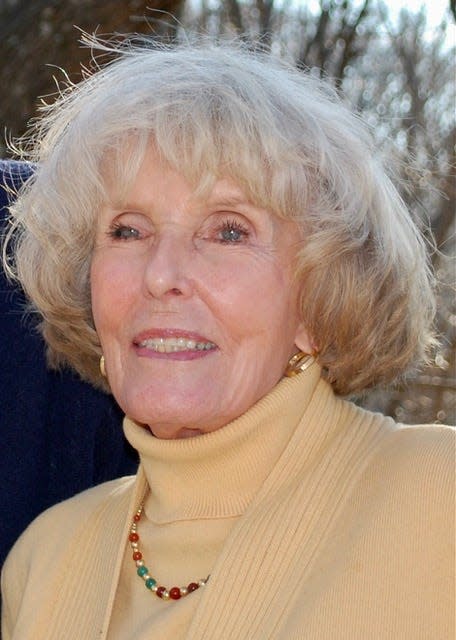Recognizing the rich artistic legacy of Columbia's Sabra Tull Meyer

Like one of the many bronze sculptures she fashioned, Sabra Tull Meyer lived a life of beauty and purpose, forever fixing herself in Missouri's memory.
A prolific force on the local art scene whose work rippled far beyond Columbia, Meyer died last week, exactly one month before she would have turned 96.
To live in Columbia means moving among Meyer's creations, holding her work in view almost daily. She created "The Shell Seeker" sculpture at Columbia Public Library, and the Don Patterson memorial at the MKT Trailhead off Stadium Boulevard.
Her work has graced such institutions as the Missouri Theatre, Stephens Lake Park, Hickman High School, the Columbia Board of Education building, multiple Columbia college campuses and more.
This presence rings almost as true across the rest of Missouri. The Corps of Discovery monument, which Meyer's daughter Sabra Johnson called her magnum opus, resides outside the Capitol in Jefferson City. Her busts of well-known Missourians — including George Caleb Bingham, Lamar Hunt and Bob Barker — live inside the statehouse.
And Meyer's busts of Kansas City Chiefs legends such as Priest Holmes and Nick Lowery occupy the team's Hall of Honor at Arrowhead Stadium.
Meyer completed her final bronze in her 95th year — a sculpture of Rose Philippine Duchesne, a French nun who ministered throughout Missouri in the first half of the 19th century and was canonized a saint in 1988.
More: From zydeco to Celtic music, check out these 5 can't-miss acts at Big Muddy Folk Festival
A 2014 Missouri Arts Council report on artists and aging foreshadowed the way Meyer would stay vibrant, still creating, to the very end.
"Sabra is aging the way we all want to. Her health is strong, her mind keen, her creativity fresh," Barbara MacRobie wrote. "She has had to make only small concessions to the mileage on the mechanism."
Meyer's passion for art propelled her to keep working through her 90s, Johnson said.
"It was something that she needed to do to express herself," she said. "Using the clay that eventually would become a bronze figure was certainly her way of expressing her artistic talent. ... I really think that's what kept her going and kept her young."
Perhaps lost in consideration of Meyer's prolific nature is the fact that she completed the Corps of Discovery monument at age 80, Johnson said. At a gathering last fall, Meyer mused on the work and said, "Oh, to be 80 again," her daughter recalled.
That work especially exhibits Meyer's attention to detail, Johnson said. To complete the figures of Lewis, Clark and their cohorts, the artist spent "at least" two years in study and preparation, ensuring she delivered every historical nuance just so, she said.
"As she said, 'If I make a mistake, it will be 8 feet tall,'" Johnson said.
Among her mother's remarkable canon, Johnson is especially drawn to figures of two young ballerinas. "The fluidity of the figures, the ponytails in the air," all the motion somehow captured in bronze, remains truly special, she said.
More: Catch Tony Danza's 'Standards and Stories' show at Arrow Rock Lyceum Theatre this month
While Meyer worked across a variety of media, something about bronze truly moved her. The union of the momentary and the enduring resonated — and offered a refreshing sense of possibility beyond one artist's lifespan, even one as long and celebrated as Meyer's.
"There’s something about the permanence of bronze that I really like," Meyer told MacRobie in 2014. "Knowing my work can still be there in a hundred years. Or even longer — they’ve brought up ancient Greek bronzes from the seabed. How cool, thinking of my art being archaeology of the future!"
Beyond Meyer's public-facing work, an intimate, ongoing archaeology is known to her family. The artist created bronze busts of each of her grandchildren.
"She wanted to capture the personality, the whim, of each grandchild. And she did that," Johnson said.
And Meyer's name will keep ringing through the lives of her loved ones — literally. The first name Sabra, accompanied by different middle names, has been passed down to the women of their family since the 1820s; Johnson's own granddaughter represents the eighth generation of Sabras, she said.
That reality seems so fitting for Meyer, whose work and spirit forms an inheritance that will be shared into the foreseeable future.
Aarik Danielsen is the features and culture editor for the Tribune. Contact him at adanielsen@columbiatribune.com or by calling 573-815-1731. Find him on Twitter @aarikdanielsen.
This article originally appeared on Columbia Daily Tribune: Sabra Tull Meyer, acclaimed Columbia sculptor, dies at 95
